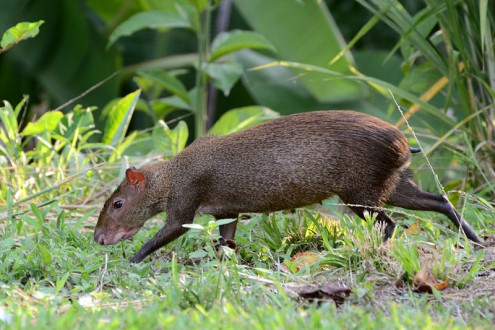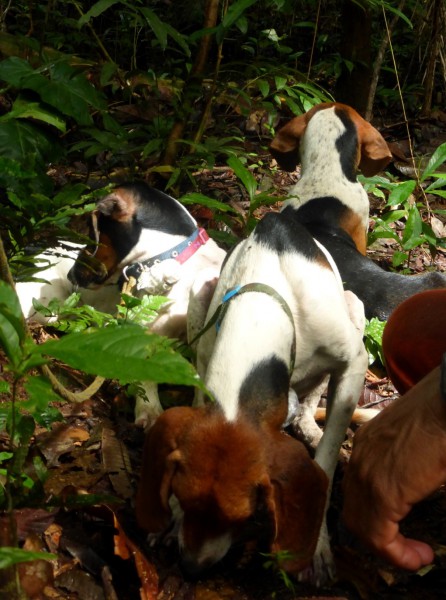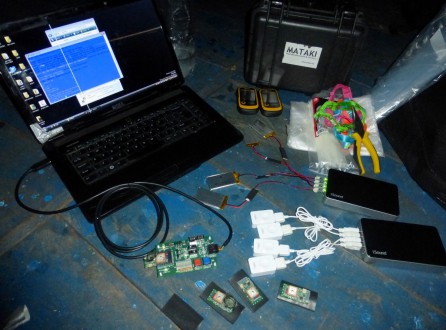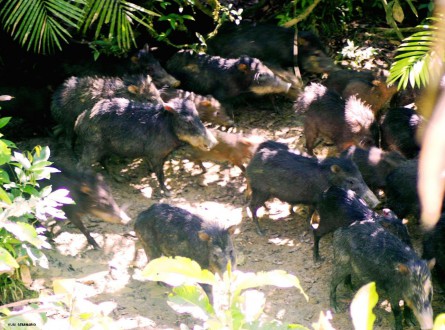- Doctoral student Mark Abrahams tracks movements of hunting dogs, even under the canopy, using Mataki, a low-cost, open-source animal monitoring platform
- Durable enough for the rainforest, several modifications to the compact, reprogrammable system, could better detect potential battery problems and device failure in the field
- Users must build and program their own Mataki devices, using freely available schematics
How do subsistence hunters use space and affect wild animal populations? Mark Abrahams, a doctoral researcher at the University of East Anglia in the UK, studies their impacts in the Brazilian Amazon. His dissertation focuses on how proximity to human subsistence hunting communities affects the population abundances of certain terrestrial game animals.

Part of Abrahams’ research focuses on the effects that the use of hunting dogs has on wildlife populations surrounding human communities. Hunters there track and trap wild game using packs of dogs that are trained and sent out to detect and follow specific animal species, and Mark wanted to determine the routes, speed, and spatial pattern of these dogs (and their owners) during their hunts to estimate the disturbance they cause to wildlife.
As part of an ongoing series looking at open-source technologies, including RFID tags and unmanned aerial vehicles, we asked Mark about his resourceful use of the Mataki animal movement tracker on several of these hunting dogs.

Designed by Dr. Robin Freeman as part of the Technology for Nature (TfN) initiative, Mataki is a lightweight, open-source tracking platform to monitor movements of wild animals via GPS. TfN’s idea was to create a programmable, flexible, tracking device with a wireless data download that was also low-cost and open-source. Mataki includes a set of software tools to help analyze the data collected.
Mataki is primarily a research project, and the TfN team doesn’t sell ready-made devices. They provide the source-code, parts list, and the schematics and designs for the basic electronics for users to then build and program their own device and develop appropriate housing for it to stay dry and clean while attached to the target animal.

Abrahams explained via email responses his use of Mataki’s open-source technology with the hunting dogs.
Wildtech: How did you learn about the Mataki device?
Through my PhD supervisor, Professor Carlos Peres, who had seen the call for collaborators.
Wildtech: Why did you select Mataki for your study, and what are some of the product’s advantages?
There were several reasons to use the devices:
- We were able to take regular, closely temporally spaced data points throughout a hunt.
- The GPS was sensitive enough to be able to log location under the forest canopy.
- Settings were flexible enough to be able to fine-tune the programming to optimise the data capture rate.
- The device was light and unobtrusive enough to attach to collars, such that they do not interfere with dog movements during a hunt.
- It was durable enough to withstand the rainforest subcanopy
- The system is cost effective enough to be able to scale up research effort to multiple sites.
- We did not need devices that could send [location] data to distant receivers, or which have very long battery lives, as the hunting dogs return to their owners at the end of a hunt.
Wildtech: Where did you deploy the Mataki device? (i.e. to what study animal and in what vegetation type?)
Tropical rainforest. Brazilian Amazon. Jurua and Uatuma regions. The study was of [domestic] hunting dogs.
Wildtech: How did you house the Mataki device? (i.e. what did you put the chip in for deployment?)
I wrapped the devices in several small plastic bags, taped shut and attached to dog collars by cable ties and more tape. This was inexpensive, virtually waterproof (the dogs frequently swam in rivers, and water almost never made it through).
Wildtech: Who designed and built the housing? (i.e. did you contract an engineer? Did you build it yourself?)
I did.
Wildtech: Which of Mataki’s open source/open access features proved most and least useful?
Most useful:
- Setgps and setacc – e.g. number of seconds taking active fixes (for GPS and accelerometer, respectively), which was very useful at limiting data acquisition. Otherwise, data took hours to download.
- Read and format commands – these were crucial.
Least useful:
- Gps 6 – set the position update rate (i.e. fixes per second). The setting didn’t seem to work, but it would have been very useful, as I would have preferred to take fewer fixes per second, for more seconds.
- battery level test – it seemed unreliable.
- manage local time – seemed to reset itself once the device turned on, therefore useless.
Wildtech: Did you modify the software or the hardware design? If so, how challenging is it for new users to modify?
I added an adapter to connect the batteries with a standard LiPoly [Lithium Polymer] USB charger. I then connected several batteries to one backup battery, allowing me to ready several batteries at a time. This was important because I would work several consecutive days. I found the components online (farnell.com) and asked the UEA [University of East Anglia] electronics workshop to create the adapters. Fairly easy.
Wildtech: Do you have any previous experience with open source software or hardware? (If yes, which one(s)?)
Very limited experience with Linux. Limited experience with R.
Wildtech: What are some of the challenges or setbacks you faced with the implementation of Mataki?
- Knowing if the batteries had been charged.
- Small cables to battery were flimsy.
- Finding the most appropriate settings for GPS and accelerometer fixes
- Charging multiple batteries and downloading data from multiple devices quickly so they could be prepared for use the next day.
- Various device failures, [which were] unpredictable and hard to diagnose.
- Hunting is a sensitive issue, so it was difficult to gain the [hunters’] trust necessary to use the devices.
- Getting the necessary firmware onto a computer requires a special cable.
Wildtech: Would you recommend using this device? If so, to whom? If not, why?
Yes, to other researchers in ecology and conservation. I would, however, warn them of the problems and advise them to double-up devices to increase the likelihood of data acquisition.
Wildtech: Would you suggest any further modifications to Mataki devices?
- A reliable way to set fixes per second
- A more sturdy battery connector
- Perhaps AA battery connector (easy to buy/replace in the field, reliable)
- Another way of getting a computer to recognize the device port
Wildtech: What is the likelihood you will use open-source technologies in future projects?
High.

Readers: Have you used Mataki or other open-source technology for monitoring wildlife, other animals of interest, or even patrol teams? Share your experiences on our Forum!
The Mataki team also invites users to get in touch if you have ideas on how to improve their devices.
